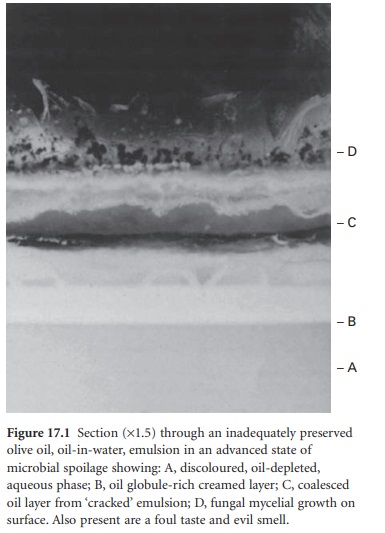Observable Effects of Microbial Attack on Pharmaceutical Products
| Home | | Pharmaceutical Microbiology | | Pharmaceutical Microbiology |Chapter: Pharmaceutical Microbiology : Microbial Spoilage, Infection Risk And Contamination Control
Microbial contaminants usually need to attack formulation ingredients and create substrates necessary for biosynthesis and energy production before they can replicate to levels where obvious spoilage becomes apparent.
OBSERVABLE EFFECTS OF MICROBIAL ATTACK ON PHARMACEUTICAL PRODUCTS
Microbial contaminants usually need to attack formulation ingredients
and create substrates necessary for biosynthesis and energy production before
they can replicate to levels where obvious spoilage becomes apparent. Thus, for
example, 106 microbes will have an overall degradative effect
around 106 times faster than one cell. However, growth and
attack may well be localized in surface moisture films or very unevenly distributed
within the bulk of viscous formulations such as creams. Early indications of
spoilage are often organoleptic, with the release of unpleasant smelling and
tasting metabolites such as ‘sour’ fatty acids, ‘fishy’ amines, ‘bad eggs’,
bitter, ‘earthy ’ or sickly tastes and smells. Products may become
unappealingly discoloured by microbial pigments of various shades. Thickening
and suspending agents such as tragacanth, acacia or carboxymethylcellulose can
be depolymerized, resulting in loss of viscosity and sedimentation of suspended
ingredients. Alternatively, microbial polymerization of sugars and surfactant
molecules can produce slimy, viscous masses in syrups, shampoos and creams, and
fungal growth in creams has produced ‘gritty’ textures. Changes in product pH
can occur depending on whether acidic or basic metabolites are released, and
become so modified as to permit secondary attack by microbes previously
inhibited by the initial product pH. Gaseous metabolites may be seen as trapped
bubbles within viscous formulations.
When a complex formulation such as an oil-in-water emulsion is attacked,
a gross and progressive spoilage sequence may be observed. Metabolism of
surfactants will reduce stability and accelerate ‘creaming’ of the oil
globules. Lipolytic release of fatty acids from oils will lower pH and
encourage coalescence of oil globules and ‘cracking’ of the emulsion. Fatty
acids and their ketonic oxidation products will provide a sour taste and
unpleasant smell, while bubbles of gaseous metabolites may be visible, trapped
in the product, and pigments may discolour it.

Related Topics
